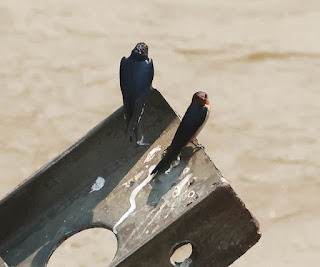The previous Blog Post had covered our first morning in Angola where we were driving from Luanda to Uige. There had been a breakfast Birding stop, as well as, a quick roadside stop. The next stop was at the Dande River bridge. When Barry Reed & co visited in Autumn 22, they found a Swallow that superficially looks like a Forest Swallow, but which has a deeper fork in the tail and a more clean-cut pale throat than the West African populations of Forest Swallow. Forest Swallow are found in Cameroon to Gabon and neighbouring regions of the Republic of the Congo & Democratic Republic of the Congo (formally Zaire) and this puts this site out of the known range for Forest Swallow. Pete Morris has included photographs of this Swallow in the Birdquest tour in Oct 22 & like Barry & co, Birdquest have proposed it is either a new subspecies of Forest Swallow or a new species. Fortunately, we saw a couple of this Forest Swallow type, but none were close enough for a photo. I did managed to get a few photos of closer species.
Red-necked Buzzard: This gorgeous monotypic Buzzard occurs from Sierra Leone to Ethiopia, Uganda & Angola
Angola Swallow: They superficially look like Swallows, but lack the broad blue-black upper breast band & long tail streamers (albeit these might not be as long as they are in the UK summer) and they have greyer rather than whiter underparts. To my eyes, they usually looked a shinier blue on the mantle. They occur from Angola & Gabon to Zambia, Malawi, Uganda, Tanzania & Test Kenya
Cassin's Grey Flycatcher: This is a river-loving species which occurs from Sierra Leone to Angola, West Uganda & extreme North Zambia
Northern Grey-headed Sparrow: This is the ugandae subspecies of this widespread species which occurs from South Mauritania to North Eritrea and South to Angola, North Namibia, North Zimbabwe & Malawi
Angolan Agama sp.: This appears to be a Namib Rock Agama, however, it appears too far North based upon the limited information I can find online, so I’ve left it as Angolan Agama sp.
Having seen the interesting Forest Swallow type, we jumped back into the 4WD and carried on for the next leg of the day. We finally arrived at the Damengola Forest in mid-afternoon. This allowed about three hours of Birding at the site before it got dark.
African Green Pigeon: This is a widespread species which occurs from Senegal to Ethiopia and as far South as South Africa
African Pied Hornbill: This is the nominate subspecies which occurs in East Nigeria to Democratic Republic of the Congo, Angola & Uganda. A second subspecies occurs from Senegal to West Nigeria
Naked-faced Barbet: This is the congicus subspecies which occurs from Western Republic of the Congo, to West Democratic Republic of the Congo & North West Angola
Braun's Bushshrike: The best-looking Bird of the day was this endemic Braun's Bushshrike. Sadly, this was the best photo I managed to take
We left at dusk for the forty minute drive into Uige. We were booked for the next two nights at one of the better hotels in the town. The rooms were uninspiring, albeit a bit bigger than the overpriced hotel in the capital & the food service was appalling. It took nearly three hours for our food to arrive and then it arrived in dribs & drabs rather than in all together: with us ending up eating about 22:00. If that was one of the better hotels in the town, it was good we weren't in one of the poor quality hotels. It had been a long but good day, with the first eleven Ticks of the seventy-five Clements Ticks seen.











